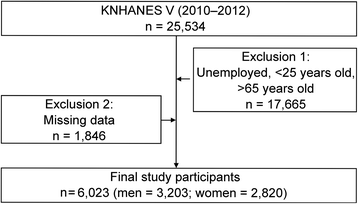Relationship between symptoms of dry eye syndrome and occupational characteristics: the Korean National Health and Nutrition Examination Survey 2010-2012
- PMID: 26511443
- PMCID: PMC4625453
- DOI: 10.1186/s12886-015-0147-3
Relationship between symptoms of dry eye syndrome and occupational characteristics: the Korean National Health and Nutrition Examination Survey 2010-2012
Abstract
Background: Dry Eye Syndrome (DES) is a broad spectrum of uncomfortable ocular conditions that are caused by reduced production of tears or an increased tear evaporation rate. This study evaluated the relationship between symptoms of DES and occupational characteristics to identify the occupation-dependent differences in the prevalence of symptoms of DES using the Korean National Health and Nutrition Examination Survey V (2010-2012) data.
Methods: A total of 6023 participants were included (3203 men and 2820 women). Questionnaires and physical examinations were used to record clinical characteristics, occupational characteristics and medical history. Odds ratios (ORs) and 95 % confidence intervals (95 % CIs) for symptoms of DES were calculated according to the occupational characteristics.
Results: Among the participants, 963 persons (16.0 %) had symptoms of DES. An increased risk (relative to the green-collar group) was observed for the ordinary white-collar (OR, 1.73; 95 % CI, 1.73-1.41), executive white-collar (OR, 1.40; 95 % CI, 1.02-1.92) and skilled blue-collar (OR, 1.44; 95 % CI, 1.04-2.00) groups. Furthermore, paid workers had a significantly higher risk of dry eye symptoms (OR, 1.21; 95 % CI, 1.02-1.45), compared to self-employed workers.
Conclusion: Our study is the first research to reveal that white-collar workers have a higher risk of symptoms of DES than blue-collar workers, that skilled blue-collar workers have a higher risk than unskilled blue-collar workers, and that paid workers have a higher risk than self-employed workers.
References
-
- Management and therapy of dry eye disease: report of the management and therapy subcommittee of the international dry eye workshop (2007). Ocul Surf. 2007;5(2):163–178. - PubMed
-
- Lemp A. Report of the National Eye Institute/Industry workshop on clinical trials in dry eyes. Eye Contact Lens. 1995;21(4):221–32. - PubMed
MeSH terms
LinkOut - more resources
Full Text Sources
Other Literature Sources
Medical


